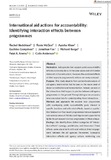| dc.contributor.author | Nadelman, Rachel | |
| dc.contributor.author | McGee, Rosie | |
| dc.contributor.author | Khan, Ayesha | |
| dc.contributor.author | Goncalves, Euclides | |
| dc.contributor.author | Fox, Jonathan | |
| dc.contributor.author | Burge, Richard | |
| dc.contributor.author | Aremu, Fatai | |
| dc.contributor.author | Anderson, Colin | |
| dc.coverage.spatial | Pakistan | en |
| dc.coverage.spatial | Nigeria | en |
| dc.coverage.spatial | Mozambique | en |
| dc.date.accessioned | 2022-12-06T09:45:54Z | |
| dc.date.available | 2022-12-06T09:45:54Z | |
| dc.date.issued | 2022-11-24 | |
| dc.identifier.citation | Nadelman, R.; McGee, R.; Khan, A.; Gonçalves, E.; Fox, J.; Burge, R.; Aremu, F.A. and Anderson, C. (2022) International Aid Actions for Accountability: Identifying Interaction Effects Between Programmes, Development Policy Review, DOI: 10.1111/dpr.12680 | en |
| dc.identifier.uri | https://opendocs.ids.ac.uk/opendocs/handle/20.500.12413/17779 | |
| dc.description.abstract | Aid agencies that support public accountability reforms commonly do so in the same places, and with similar state and civil society actors. However, the combined effects of their separate programmatic actions are rarely analysed. This study departs from conventional analysis of aid agency relationships that focuses on the macro level of donor co-ordination and harmonization. Instead we look at the interactions that happen in practice between aid agency programmes on the ground. Through doing so we propose a new conceptual lens for understanding these interactions. We explore how programmes with overlapping public accountability goals interact in specific locations and with what effects, based on qualitative fieldwork on four recent programmes that overlapped in sub-national areas of Pakistan and Nigeria and supported by lighter-touch research on two programmes in Mozambique.
We identify three distinct categories of “interaction effects”—synergy, parallel play, and disconnect. These effects came about both with and without direct engagement between the aid agencies themselves. Synergistic interaction effects—aid agency actions reinforcing one another in pursuit of greater public accountability—were common. Parallel play—siloed working—was also common, risking missed opportunities to extend impact. The study identified one outright disconnect—where aid agency actions undermined each other. Using this “interaction effects” lens in practice could inform and strengthen aid agency strategies—avoiding conflicting actions and siloed working—and achieving more through synergy with others, particularly in complex contexts. This applies both in programme design and in adapting to other aid programmes’ actions in real time. Development programme research and evaluations would benefit from broadening their lens beyond single-programme studies to understand the combined effects of multiple actors | en |
| dc.language.iso | en | en |
| dc.publisher | John Wiley & Sons, Ltd | en |
| dc.rights.uri | http://creativecommons.org/licenses/by/4.0/ | en |
| dc.subject | Aid | en |
| dc.subject | Development Policy | en |
| dc.subject | Governance | en |
| dc.title | International Aid Actions for Accountability: Identifying Interaction Effects Between Programmes | en |
| dc.type | Article | en |
| dc.rights.holder | © 2022 The Authors. Development Policy Review published by John Wiley & Sons Ltd on behalf of ODI | en |
| dc.identifier.externaluri | https://onlinelibrary.wiley.com/doi/epdf/10.1111/dpr.12680 | en |
| dc.identifier.team | Power and Popular Politics | en |
| dc.identifier.doi | 10.1111/dpr.12680 | |
| dcterms.dateAccepted | 2022-10-26 | |
| rioxxterms.funder | Department for International Development, UK Government | en |
| rioxxterms.identifier.project | PO7239 Action for Empowerment and Accountability Programme | en |
| rioxxterms.version | VoR | en |
| rioxxterms.versionofrecord | 10.1111/dpr.12680 | en |
| rioxxterms.funder.project | 5cecb4e4-a784-4ff9-b559-66fc23b1b999 | en |


